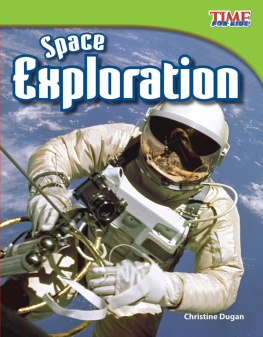Alberto Hernández Pamplona - A Visual Guide to Space Exploration
Here you can read online Alberto Hernández Pamplona - A Visual Guide to Space Exploration full text of the book (entire story) in english for free. Download pdf and epub, get meaning, cover and reviews about this ebook. publisher: The Rosen Publishing Group, Inc, genre: Religion. Description of the work, (preface) as well as reviews are available. Best literature library LitArk.com created for fans of good reading and offers a wide selection of genres:
Romance novel
Science fiction
Adventure
Detective
Science
History
Home and family
Prose
Art
Politics
Computer
Non-fiction
Religion
Business
Children
Humor
Choose a favorite category and find really read worthwhile books. Enjoy immersion in the world of imagination, feel the emotions of the characters or learn something new for yourself, make an fascinating discovery.
- Book:A Visual Guide to Space Exploration
- Author:
- Publisher:The Rosen Publishing Group, Inc
- Genre:
- Rating:5 / 5
- Favourites:Add to favourites
- Your mark:
- 100
- 1
- 2
- 3
- 4
- 5
A Visual Guide to Space Exploration: summary, description and annotation
We offer to read an annotation, description, summary or preface (depends on what the author of the book "A Visual Guide to Space Exploration" wrote himself). If you haven't found the necessary information about the book — write in the comments, we will try to find it.
A Visual Guide to Space Exploration — read online for free the complete book (whole text) full work
Below is the text of the book, divided by pages. System saving the place of the last page read, allows you to conveniently read the book "A Visual Guide to Space Exploration" online for free, without having to search again every time where you left off. Put a bookmark, and you can go to the page where you finished reading at any time.
Font size:
Interval:
Bookmark:

Description: New York : Rosen Publishing, 2018 | Series: A visual exploration of science | Audience: Grades 712. | Includes bibliographic references and index. Identifiers: LCCN 2017002112 | ISBN 9781508175834 (library-bound) Subjects: LCSH: AstronomyHistoryJuvenile literature. | Outer spaceExplorationJuvenile literature. | Outer spaceExplorationHistoryJuvenile literature. Classification: LCC QB46 .P25 2018 | DDC 629.43/5dc23 LC record available at https://lccn.loc.gov/2017002112 Manufactured in the United States of America Metric Conversion Chart 1 inch = 2.54 centimeters; 25.4 millimeters
1 foot = 30.48 centimeters
1 yard = .914 meters
1 square foot = .093 square meters
1 square mile = 2.59 square kilometers
1 ton = .907 metric tons
1 pound = 454 grams
1 mile = 1.609 kilometers
1 cup = 250 milliliters
1 ounce = 28 grams
1 fluid ounce = 30 milliliters
1 teaspoon = 5 milliliters
1 tablespoon = 15 milliliters
1 quart = .946 liters
355 degrees F = 180 degrees Celsius 2018 Editorial Sol90, S.L.
Barcelona
All Rights Reserved.
Original Edition 2009 Editorial Sol90, S.L. Barcelona Original Idea Sol90 Publishing
Project Manegement Nuria Cicero
Editorial Coordination Diana Malizia
Editorial Team Alberto Hernndez, Virginia Iris Fernndez, Mar Valls, Marta de la Serna, Sebastin Romeu. Maximiliano Luduea, Carlos Bodyadjan, Doris Elsa Bustamante, Tania Domenicucci, Andrea Giacobone, Constanza Guariglia, Joaqun Hidalgo, Hernn Lpez Winne.
Proofreaders Marta Kordon, Edgardo DElio
Design Fabin Cassan
Layout Laura Ocampo, Carolina Berdias, Clara Miralles, Paola Fornasaro, Mariana Marx, Pablo Alarcn Photography Age Fotostock, Getty Images, Science Photo Library, Graphic News, ESA, NASA, National Geographic, Latinstock, Album, ACI, Cordon Press Infographic Coordination Paula Lpez Infographies Sol90 Images www.sol90images.com, Paula Lpez, Guillermina Eichel, Pablo Gentile, Maru Hiriart, Maureen Holboll, Clarisa Mateo, Sol Molina, Vanina Ogueta, Gastn Prsico, Cecilia Szalkowicz, Paula Simonetti Illustrations Sol90 Images www.sol90images.com, Guido Arroyo, Pablo Aschei, Gustavo J. Caironi, Hernn Caellas, Leonardo Csar, Jos Luis Corsetti, Vanina Faras, Joana Garrido, Celina Hilbert, Isidro Lpez, Diego Martn, Jorge Martnez, Marco Menco, Ala de Mosca, Diego Mourelos, Eduardo Prez, Javier Prez, Ariel Piroyansky, Ariel Roldn, Marcel Socas, Nstor Taylor, Trebol Animation, Juan Venegas, Coralia Vignau, 3DN, 3DOM studio, Constanza Vicco, Diego Mourelos. Contents A Voyage into the Future The Conquest of Space Flying Through Space Permanent Exploration Visiting Other Worlds Applied Astronautics Glossary For More Information For Further Reading Index A Voyage into the Future  THE IMPRINT OF HUMANKIND
THE IMPRINT OF HUMANKIND
The footprints of the astronauts are clearly visible in the soil of the Moon. D uring the greater part of our history, the Moon was quite unreachable. It did not seem very big and far away but rather small.
For the Greeks, the idea of walking on the Moon was certainly unthinkable, and as recently as the end of the 19th century many people doubted that humans would even be able to fly. Nevertheless, on July 20, 1969, the miracle happened. Since then many historic missions to explore the planets have been planned and executed, with the spacecraft and probes Mariner, Viking, Pioneer, Voyager, and Galileo leading the way. Thanks to human intelligence and effort we have succeeded in exploring many corners of our solar system. This book intends to show all this: the history of manned and unmanned voyages and the discoveries that were made. We will try, using simple and accessible language, to answer many questions, such as what rockets are, how they work, what shuttles exist, how astronauts live in space, and which robot probes are visiting other planets looking for signs of life.
All this is accompanied by photographs and top-quality illustrations, providing a better picture of the successes by which we have made giant steps in our understanding of the composition of the other planets, their origin, and their evolution. Every day astronomers are more convinced that there are other places in the universe that are like Earth. We only have to find them. They also assure us that this is one of the most interesting moments in the exploration of the solar system, because so many things are being revealed. Orbiting spacecraft such as Mars Odyssey and Mars Express have confirmed the existence of ice under the surface of Mars. Sending exploratory spacecraft to Saturn was another prodigious feat, a demonstration of human capacity to dream of new worlds.
In 2015, the New Horizons space probe became the first craft to do an exploratory flyby of Pluto. This shows that the search has only begun. There is still far to go. Perhaps life may be found farther away than we had imagined. Or maybe, as some dreamers imagine, in the next decade we will realize the project of colonizing other planets. For now, the best candidate for us to land on is Mars.
But that is still only a dream, the same kind of dream that was made into reality when humans left their footprints on the Moon. The Conquest of Space  YURI GAGARIN
YURI GAGARIN
The Russian cosmonaut in the cabin of the spacecraft Vostok 1. T he human adventure in space began with Yuri Gagarin, the first Russian astronaut, who in 1961 reached an altitude of 196 miles (315 km) and orbited the Earth in the spacecraft Vostok 1. The cosmonaut had practically no control over the apparatus, which was remotely controlled by Soviet engineers. The next step was made by the United States with the arrival of astronauts on the Moon. Neil Armstrong became the first man to set foot on the Moon, followed by Edwin Aldrin. The success of the Apollo 11 mission marked the culmination of a long and costly space project whose objective was to explore Earths only natural satellite. In the following decades, the space program has had many significant successes.
Destination: Other Worlds T he space age began in 1957 with the launching of the first artificial satellite. Since that time, astronauts and space probes have left the Earth to investigate space. To date, 12 men have visited the Moon. Advances in astronautics have made it possible to develop automatic navigational systems with which a spacecraft can reach and enter orbit around a planet. The Mars Express probe, launched in 2003 to take photographs of Mars, used this system. Mars Express, one of the European Space Agencys most productive missions around the Red Planet, is powered exclusively by solar energy. From Fiction to Reality A
From Fiction to Reality A
Font size:
Interval:
Bookmark:
Similar books «A Visual Guide to Space Exploration»
Look at similar books to A Visual Guide to Space Exploration. We have selected literature similar in name and meaning in the hope of providing readers with more options to find new, interesting, not yet read works.
Discussion, reviews of the book A Visual Guide to Space Exploration and just readers' own opinions. Leave your comments, write what you think about the work, its meaning or the main characters. Specify what exactly you liked and what you didn't like, and why you think so.












